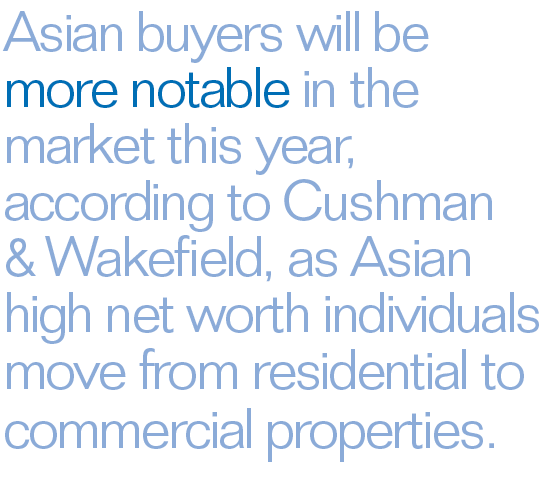High prices, low yields and volatility in their domestic markets have pushed Asian investors to increase acquisitions of U.S. office properties, particularly in the West Coast markets of Los Angeles, San Francisco and Seattle.
The U.S. has overtaken China to become the world’s largest real estate investment market, according to Cushman & Wakefield’s recently released International Investment Atlas 2015. Asian investment into U.S. commercial real estate totaled $7 billion for all of 2014, then surged to $3.3 billion just in the first quarter of this year, according to a recent report by CBRE. More than half of that money went into the office sector, and the West Coast dominates that activity. In 2014, for example, Los Angeles and San Francisco saw 41 percent of the acquisition activity, mostly with office sites, according to the CBRE report.
Russell Ingram, vice chairman of CBRE’s capital markets division, says it is easier for cross-border investors to find attractive deals in the U.S., especially if they are from countries such as China and Japan.
 “There’s this increase in global liquidity, and it’s a trend for Asian investors, partly because of rule changes, to seek out U.S. properties as compared to looking in their expensive local markets,” he says. “Office is attractive because of the fundamentals. Many of the Asian groups are [in for] 20- to 30-year-hold, they’re after CBD property. Also, they understand office the best, they don’t have as much experience with logistics and multifamily.”
“There’s this increase in global liquidity, and it’s a trend for Asian investors, partly because of rule changes, to seek out U.S. properties as compared to looking in their expensive local markets,” he says. “Office is attractive because of the fundamentals. Many of the Asian groups are [in for] 20- to 30-year-hold, they’re after CBD property. Also, they understand office the best, they don’t have as much experience with logistics and multifamily.”
The top global markets haven’t changed: New York City is still the largest overall target for investment, and London is the biggest cross-border draw. Both cities are also considered as two of the top three most expensive cities for rents, and real estate services firm DTZ just rated London and New York as the most expensive per office workstation, with the latter rated at almost $23,000 per workstation, according to the firm’s recent Global Office Thermometer.
Going West
However, Los Angeles and San Francisco are also popular investment regions, taking the number four and five slots, according to Cushman & Wakefield. Asian investment in West Coast properties increased substantially in the first half of 2015, including Hong Kong-based Gaw Capital’s recent $725 million deal for Seattle’s Columbia Center and Beijing-based Oceanwide Holdings’ agreement to buy the planned office development site at First and Mission Streets in San Francisco for $296 million. The West Coast markets are drawing attention as investors seek cheaper investment options.
Lewis Horne, president of the Los Angeles region for CBRE, said in a statement that Asian investment in the city shot up 20 percent from 2013 to 2014, the biggest increase for any U.S. market. “These investors are continuing to pour capital into the Los Angeles economy as development projects get underway, creating jobs and spurring economic activity,” he said.
Asian buyers will be more notable in the market this year, according to Cushman & Wakefield, as Asian high net worth individuals move from residential to commercial properties. Asian investors’ interest in U.S. office assets will continue to grow, in part because of relaxed legislative rules for new sources of capital, such as Chinese insurance companies. China has increased its U.S. investment from $100 million in 2013 to almost $2 billion in 2014, and that figure will likely continue to increase.
Japanese investors are also poised to increase their holdings here, Ingram says. “Japan will be big, it is just building slowly, they study things extensively before making significant moves,” he says. “They are now seeing a big push for diversification outside stocks and bonds, and there’s talk they will allocate as much as 20-25 percent to alternative assets, with real estate as the largest component.”

